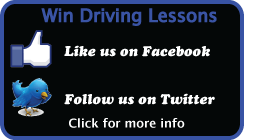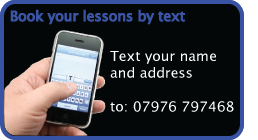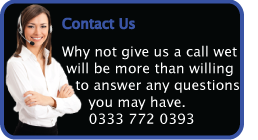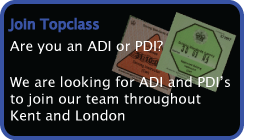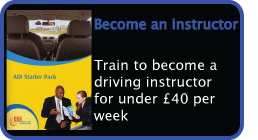 Book a lesson
Book a lesson
Would you like to book a lesson, simply fill in our booking form and we will get back to you to confirm a date.
Please complete all mandatory fields(*)
Topclass driving school Gillingham, driving lessons in Gillingham, Medway, and most of Kent
Top 10 reasons for failing your driving test
Failing a driving test can be disappointing. You may have had a lot that depended on you passing. For instance, you may have needed to pass to get a new job or promotion at work, or you might have needed to pass so you can be a second driver in the family. However, all is not lost. You just need to re-apply for a second test ASAP. If you have got the confidence and skills, then there is no reason why you can't do it next time.
1. Not acting correctly at road junctions.
It's vital that you use the Mirrors, Signal, Position, Speed (Gears) and Look routine when your approach any kind of junctions including Roundabouts, T Junctions and Side roads. You must check that that any new junction is safe to drive into or out of. That's essential when you are turning either left or right. Is your position correct? are you in the correct Gear, Was your speed on approach too high? If this was the case, then you may not have been able to stop if needed.
2. Reversing around a corner
Most candidates fail on this due to either the lack of control of the car of lack of observation. When reversing around a corner it's important to keep the car moving as slowly as possible using good clutch control. This gives you time to decide when to steer at the correct turning point. It's also essential that you keep looking all around the vehicle for any other road users in the surrounding area, and act appropriately.
3. Steering faults
Losing control of your steering wheel, either in normal driving or during a Manoeuvre. This could be because you have allowed the steering wheel to 'spin through your hands' or have crossed your hands while steering. ( use of the Push Pull method of steering is essential )
4. Reverse parking faults
The reverse parking exercise can be one of the hardest of the manoeuvre's to do successfully. Like all of the other Manoeuvre's, it needs careful use of the controls (clutch control ) to keep the vehicle moving very slowly, so that you have time to decide when to steer at the right time. You should also be aware of all other road users in the surrounding area, and act appropriately if you see anyone else, while you're completing the task.
5. Making proper use of the gears
It is essential to use the correct gear for the speed, road and traffic conditions. As an example, if you are approaching or driving through a lot of hazards, then it's important to drive in a lower gear. However if there are few hazards, then the examiner will expect you to be in the highest gear available. A common error is to stay in a low gear (and this will include third gear) unnecessarily.
Another area where people often fail on gears, is forgetting to select 1st gear before moving off. If it results in the car stalling, this could possibly cause inconvenience to other road users, or have dangerous consequences to other road users.
6. Not using the mirrors correctly
Why do you need to check you mirrors? It's essential to know if there are any other road users following behind you. This is to enable you to make a safe and sensible decision before you start any manoeuvre (Any change of speed or direction). Roughly speaking, you should check your mirrors between 25 and 50% of your driving time only glancing in the mirrors. If you spend any more time looking at your mirrors you are not paying enough attention to the road.
An 'old wives' tale' says that you have to move your head when you make your mirror checks. Driving examiners are trained to watch you check your mirrors without you having to emphasize that you are checking them.
7. Avoiding hesitation and driving too slowly.
You may not pass if you stop somewhere unnecessarily. For example giving way to traffic where it's safe to continue without stopping.
The examiner will expect you to keep up with the flow of traffic within the legal limit, providing the road conditions allow you to do so. Driving too slowly when it's safe to drive at the legal limit could cause inconvenience to others.
8. Acting correctly when turning right
Remember your MSM PSL routine, check your Mirrors, Signal, and Position to the right of the lane you are in just left of the centre line. Adjust your Speed and select your gear accordingly. Wait for an appropriate gap in the oncoming traffic. You must not cut across oncoming traffic or cut the corner the aim is not to hold other people up unnecessarily. If someone flashes you to go, decide if it's safe then move away.
9. Hesitation at junctions
The driving examiner will expect you to be able to judge gaps and speed and distance correctly when either pulling out, or turning right. You should not pull out, or turn if it will cause the approaching traffic to slow down or make them swerve to avoid you.
10. Moving away from stationary positions.
The most common reasons for failing on moving away are, moving off in the wrong gear, forgetting to turn the indicator off if you've used a signal, rolling back if you're moving off on a hill, or not looking around to check the blind spot to make its safe go.
Training
It's important to make sure that you have sufficient training before you take the driving test. In our experience, a lot of learners think that they can take the test with the minimum amount of lessons, and hope to pass. We believe that's false economy. And in the long run it will cost you more money.
If you fail, it's important you continue with the training so you'll keep up to standard. In our experience, if you stop your training before taking another test this is false economy. Many people often fail through lack of continuity of their training. Even an hour a week is better than none at all. The DSA's national pass rate figure is 43%. The DSA suggest a minimum of 40 hours plus 30 hours of private practice, before taking a driving test to give you a good chance of passing.
For your convenience we now accept all major credit / debit cards.














